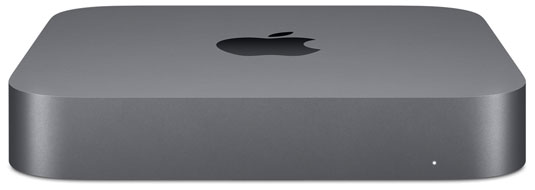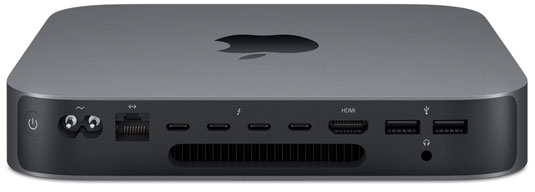Hosted by site sponsor WebMate.
Aluminum "Unibody" Mac mini Q&A
Update Published December 14, 2020
All Mac Q&As >> Aluminum Mac mini Q&A (Home)
To be notified of new Q&As, sign up for EveryMac.com's bimonthly email list.
What are all the differences between the "Late 2018" Space Gray Aluminum Mac mini models? Which is best for me?
On November 10, 2020, Apple discontinued the entry-level Mac mini "Core i3" 3.6 (Late 2018), but continues to sell the higher-end Mac mini "Core i5" 3.0 (Late 2018) and configure-to-order Mac mini "Core i7" 3.2 (Late 2018). This EveryMac.com Q&A has been updated accordingly.
Unlike earlier Aluminum Mac mini lines, which often had major internal differences between systems, there only are two stock "Late 2018" Aluminum Mac mini models -- the Mac mini "Core i3" 3.6 (Late 2018) and "Core i5" 3.0 (Late 2018) -- and one configure-to-order model, the Mac mini "Core i7" 3.2 (Late 2018).

Photo Credit: Apple, Inc. (Mac mini 2018)
By contrast, the "Late 2018" Mac mini models only differ by processor and storage internally. However, these processor differences are significant and it is important to understand the similarities that all models share, too.
External & Connectivity Similarities
All three "Late 2018" Mac mini models use the same 7.7 inch by 7.7 inch "cuboid" dark Space Gray-colored aluminum case and the same extensive complement of ports.

Photo Credit: Apple, Inc. (Mac mini Late 2018 Models - Ports)
The "Late 2018" Mac mini models include four Thunderbolt 3 (USB-C connector) ports, two USB 3.1 ports, an HDMI 2.0 port, Gigabit Ethernet (configurable to NbaseT/10 Gigabit Ethernet at the time of system purchase), 802.11ac Wi-Fi (802.11a/b/g/n compatible), Bluetooth 5.0, and an old school 3.5 mm headphone jack. They do not have an SD card slot or IR support for a remote.
Identification Differences
Externally, the "Late 2018" Mac mini models -- which Apple formally just refers to as the "2018" line without further detail -- share the A1993 Model Number.
At the time this system was released, this Model Number was sufficient for identification purposes because no earlier models share this identifier. However, subsequent models likely will use the same Model Number and it likely will be insufficient in the future.
Accordingly, just as the site has done for the past two decades, EveryMac.com has carefully hand documented that the "Late 2018" Mac mini models also have a unique EMC Number -- 3213 -- externally and a unique Model Identifier -- Macmini8,1 -- in software. These identifiers are likely to stay unique in the future.
The EMC Number is listed on the bottom of the Mac mini toward the ports. To locate the Model Identifier in software, select "About This Mac" under the Apple Menu on your computer, click the "More Info..." button, and finally click the "System Report" button.
EveryMac.com's Ultimate Mac Lookup feature also can identify the "Late 2018" Mac mini models by their Serial Numbers.
Internal Differences
With the exception of processor speed/cores and storage capacity, the "Late 2018" Mac mini models are identical internally. All have eighth generation "Coffee Lake" processors, an integrated Intel UHD Graphics 630 graphics processor, RAM that can be upgraded after the initial purchase of the system, and PCIe-based storage that is soldered in place and cannot be upgraded later.
As enumerated below, higher-end models also ship with faster processors with more cores and more default storage.
Comparison Chart
Configuration differences are summarized below for the two original default models and the BTO/CTO option along with price differences:
 i3 3.6 |
 i5 3.0 |
 i7 3.2 (BTO*) |
|
|---|---|---|---|
| Current Model: | No | Yes | Yes |
| Processor Speed: | 3.6 GHz | 3.0 GHz | 3.2 GHz |
| Turbo Boost: | None | 4.1 GHz | 4.6 GHz |
| Processor Cores: | 4 | 6 | 6 |
| Processor Type: | Core i3 (8100B) | Core i5 (8500B) | Core i7 (8700B) |
| L3 Cache: | 6 MB | 9 MB | 12 MB |
| Std. RAM: | 8 GB | 8 GB | 8 GB |
| Max. RAM: | 64 GB† | 64 GB† | 64 GB† |
| Graphics Processor: | UHD 630 | UHD 630 | UHD 630 |
| VRAM Type: | Integrated | Integrated | Integrated |
| Std. Storage: | 128 GB | 256 GB | 128/256 GB |
| Std. Storage Type: | SSD | SSD | SSD |
| Max. Storage: | 2 TB‡ | 2 TB‡ | 2 TB‡ |
| Order Number: | MRTR2LL/A | MRTT2LL/A | BTO/CTO |
| Orig. Price (US): | US$799 | US$1099 | US$1099 US$1299 |
| Orig. Price (UK): | £799 | £1099 | £1069 £1249 |
| Orig. Price (CA): | C$999 | C$1399 | C$1399 C$1639 |
| Orig. Price (AU): | A$1249 | A$1699 | A$1699 A$2019 |
* This system is a configure-to-order option for either of the standard "Late 2018" Mac mini models.
† The RAM in all of these models is upgradable and can be upgraded after system purchase.
‡ This is the maximum amount of storage available for each model as configurable from Apple at the time of purchase. Because the storage is soldered in place, it cannot be upgraded later.
For pricing information in dozens of other countries, refer to EveryMac.com's Global Original Prices section.
So, which "Late 2018" Mac mini model is best for me?
The biggest shared limitation of the "Late 2018" Mac mini models is that the storage is soldered in place and cannot be upgraded in the future. Of course, it is simple to add fast Thunderbolt 3-based external storage later, but it still is worth keeping in mind. Another shared limitation is that none are particularly cheap.
Although all have relatively fast multicore processors, EveryMac.com would recommend that most users buy the standard high-end Mac mini "Core i5" 3.0 (Late 2018) model.
The value proposition may have changed somewhat now that it is discontinued and only available on the used market, but the entry-level Mac mini "Core i3" 3.6 (Late 2018) model was worth considering. However, the higher-end model is as much as 46% faster in multicore tasks but only originally cost 37% more, which includes the benefit of twice as much storage (adjusted for the storage price it is only 10% more), so the higher-end option was a better value for those with a bit of extra money to spend.
The entry-level model is best suited for someone who already has a compatible display and keyboard and wanted the cheapest new desktop Mac possible at the time it was released. Of course, for those whom price is an issue can choose from any number of used Mac mini models to save additional money.
The configure-to-order Mac mini "Core i7" 3.2 (Late 2018) also is a fair value. It provides roughly 20% more multicore performance than the standard high-end Mac mini "Core i5" 3.0 (Late 2018) model, but only costs 18% more.
In the US, site sponsor Other World Computing sells used and refurb Mac mini models at bargain prices with free shipping, as well.
In the UK, site sponsor Hoxton Macs sells used Mac mini models with a one-year warranty and free next day delivery throughout the UK.
Please refer to the Ultimate Mac Comparison feature to dynamically compare any Mac mini model to any other G3 or later Mac.
Permalink | Report an Error/Typo | Sign Up for Site Update Notices
Suggest a New Q&A | Sign Up for Bimonthly Site Update Notices
<< Aluminum "Unibody" Mac mini Q&A (Main) | All Mac Q&As
Established in 1996, EveryMac.com has been created by experts with decades of experience with Apple hardware. EveryMac.com includes, and always has included, original research incorporating detailed, hands-on inspection of packaging, computers, and devices as well as extensive real-world use. All information is provided in good faith, but no website or person is perfect. Accordingly, EveryMac.com is provided "as is" without warranty of any kind whatsoever. EveryMac.com, and the authors thereof, shall not be held responsible or liable, under any circumstances, for any damages resulting from the use or inability to use the information within. For complete disclaimer and copyright information please read and understand the Terms of Use and the Privacy Policy before using EveryMac.com. Copying, scraping, or use of any content without expressed permission is not allowed, although links to any page are welcomed and appreciated.
